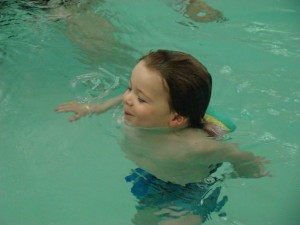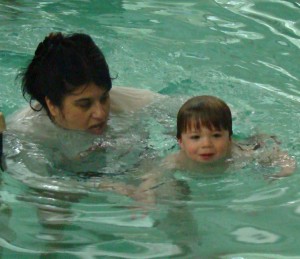“Harry is one of those kids with no fear of water. He terrified me last summer around any pool, as he showed no hesitation about jumping right in. I put him in a floatation vest, which furthered his false sense of confidence,” shares Harry’s mom, member Carley Fisher-Maltese. Teaching Harry to swim became a priority before another season was spent poised for rescue at the pool’s edge.
Harry started group swim classes with Aquatics Instructor Corina Simms, after high recommendations of her and the Center’s Aquatics Programs. Washed away were Harry’s days of free floating granted by his inflatable vest. “It was time to break the bad habits and false security the floatation vest provided. I recommended an instructional swim belt, a better tool when learning to swim,” informs Corina. The first day of swim class was a challenge. Harry was accustomed to more independence from his vest-wearing times. His water kingdom was transforming.

Quickly, Harry started to enjoy the group lessons. After only a few months, 27-month-old Harry was treading water, traveling to the pool’s side, and pulling himself out on his own. Success stories like his are perhaps why the American Academy of Pediatrics (AAP) recently expanded their guidelines to suggest swimming classes for younger children as well.
The AAP’s previous guidelines recommended most children ages 4 and older learn to swim. Current evidence indicates even younger children (ages 1 to 4), who have had formal swimming instruction, benefit from a reduced risk of drowning. Therefore, the AAP is no longer opposed to swim classes for younger children. Their current recommendation is for parents to decide, on an individual basis, whether to enroll a child in swim lessons. This should be determined by the child’s frequency of exposure to water, emotional development, physical abilities, and certain health concerns related to pool water infections and pool chemicals.
The quality of instruction can have a huge impact. “I like how Corina focuses on water safety skills with a foundation based on the Red Cross guidelines. My husband and I are not interested in Harry being an Olympic swimmer, at this point. Our goal is for him to safely enjoy the water,” provides Carley.
As with any instruction, swimming lessons must be age appropriate. Aquatic programs are structured around a typical child’s development at any given age. The youngest participants are usually best enrolled in a parent-and-me type class. Parents and children can experience water fun while the child becomes familiar with water in the security of a parent’s arms. As they advance, they can go bravely one-on-one with an instructor.
Teaching an Old Doggy-Paddler New Tricks
With an adult, there is often a lifelong psyche to surmount, created from worries, habits, experience, and news that reports swimming events of Olympic proportions (overwhelming) and stories of tragic drownings (fearful). Not to mention, some adults feel self-conscious clad in a swimsuit just lounging by the pool. The Center’s Aquatic Center is comfortable and welcomes all skill levels and age groups.
“The atmosphere is not intimidating. I never feel like a spectacle,” shares one 50-year-old member enrolled in the adult swim program. Often, seniors can be found splashing through an aquatic workout, some established swimmers and others using floatable noodles to accomplish arthritis relief. “It’s safe here. There is always a lifeguard and certified instructor available,” shares one hearty senior on how he’s free to live out his Jacques Cousteau fantasy at the Center pool.

Effective Swim Lessons
- Safety must come first, always. Leaning specific swim strokes is secondary at this stage.
- Lessons should focus on safety basics, including holding your breath, jumping in deep water, returning to the pool’s side from the center, and floating.
- Assure a calm environment with minimal distractions.
- Consider private lessons. The instructor can better connect with your little guppy and understand his/her best learning style. This is also especially effective for shy children (and adults) who may be intimidated in groups.
- Make sure children (or you) are ready for lessons. If he/she is resistant, then learning can be a chore. A long-term bad association might even develop. (Remember those piano lessons you were forced to take as a child.)
Stay Focused Around Water
Swim lessons are only part of a comprehensive water safety plan. Remain steadfast with childproofing precautions around swimming pools, hot tubs, and all other bodies of water. Swimming lessons don’t make learners drown-proof, and we’re always learning. A child can drown in as little as an inch of water, including in bathtubs, decorative fountains, birdbaths, and buckets. Appropriate supervision and precautions should be taken with all non-swimmers, young and old. Even strong swimmers would be wise to follow the buddy system.
When leaving your child with a caregiver or summer camp counselor, be sure they utilize appropriate safety features. Inform them of your child’s water habits and capabilities. Consider learning CPR. Suggest the same for those in whose care you leave your child.
Extra Tip for Adult Beginners
You might not look as adorable in a frog bikini as the toddler in the splash fest before your class, but accept yourself as you are. The Center isn’t looking for the next beach babe. Unlike some locales where swimsuits are worn, the Center offers positive, professional aquatic instruction in a nonjudgmental environment. (You needn’t accomplish the perfect bikini bottom before you conquer swimming.) Be happy with whom you are, and the person you are continuously becoming.
Be realistic in your expectations. Building skills takes time. The Center pool is available, at just the right temperature, year round. Continue to practice between and beyond your enrollment in an aquatics program. Repetition is needed to gain progress and water safety. You must conquer skills one level at a time, and at your own pace. Don’t expect to walk on water—save that for miracle workers.
 “The more swimming lessons and training, the better it is. Swimming is a lifesaving skill first, followed by a great way to exercise and have fun once safety lessons are mastered. Harry is well on his way,” assures Corina. Is your child? Are you?
“The more swimming lessons and training, the better it is. Swimming is a lifesaving skill first, followed by a great way to exercise and have fun once safety lessons are mastered. Harry is well on his way,” assures Corina. Is your child? Are you?
Summer is a time for relaxing in the sun. Delight at a nearby pool, lake, or ocean where you can refresh yourself with water fun. With the benefit of aquatic safety skills, every family member can feel confident. Your biggest concern can be applying enough sunscreen.
Sources
“AAP Gives Updated Advice on Drowning Prevention,” AAP News Room press release at www.aap.org.
“Do Swimming Lessons for Very Young Children Help Lessen the Risk of Drowning?” Robin McClure at www.about.com.
“Swim Lessons for Kids,” Vincent Iannelli, MD at www.about.com.
 Fitness & Wellness News Your Source for Fitness News, Wellness News, Health News, and Nutrition News!
Fitness & Wellness News Your Source for Fitness News, Wellness News, Health News, and Nutrition News!



